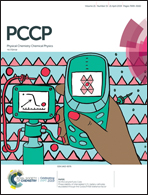Phase stability of intercalated V2O5 battery cathodes elucidated through the Goldschmidt tolerance factor†
Abstract
Orthorhombic V2O5 is a promising Mg battery cathode material, and reversible intercalation in the layered α-phase has been claimed experimentally. However, these results, based on electrochemistry and XRD, are controversial. Previous computational studies have predicted high activation barriers (∼1 eV) for ionic migration in α-V2O5, although improved Mg2+ mobility is expected in the δ-phase. Here, hybrid-exchange density functional theory is used to discuss structure, stability and intercalation in the α and δ phases, beginning with a model system with MV2O5 stoichiometry, and varying ionic radius of the M cations. The relative stability of the two phases upon intercalation of M is rationalised through a tolerance factor-like behavioural trend, providing a framework for phase selection using intercalants of different ionic size. This tolerance factor behaviour is due to the presence of ferroelectrically distorted (2 × 2 × 2) perovskite blocks within the α-V2O5 structure. The δ-phase is found to undergo a barrierless phase change to α in fully charged (de-intercalated) MgxV2O5 (x = 0), indicating that stabilisation of δ-MgxV2O5 is required at low x if the δ phase is to be retained for higher Mg mobility. By employing dispersion interactions to accurately reproduce the interlayer distance, activation barriers for ion migration are found to be higher than reported in previous studies, clarifying questions regarding the extent of Mg intercalation that can be achieved experimentally. Interlayer ions are found to lower activation barriers for Mg2+ mobility by up to ∼330 meV in the α phase by expanding the interlayer space. The results address open questions about the electrochemical performance of orthorhombic V2O5 as Mg battery cathode material, and indicate atomic level mechanisms that activate ionic mobility in layered V2O5.

- This article is part of the themed collection: 2019 PCCP HOT Articles


 Please wait while we load your content...
Please wait while we load your content...